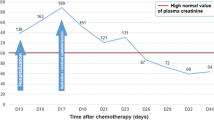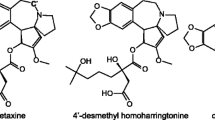Summary
The excretion patterns of cyclophosphamide (CP) in urine were studied in 54 tumor patients aged between 21 and 61 years, using the nitrobenzyl-pyridine (NBP) reaction, with regard to the route of application (i.v., i.m. or oral), the CP dose and the functional state of the liver and kidney.
The studies were carried out in nephrectomized patients and patients with liver affections caused by the basic disease, in particular with malignant lymphomas and mammary carcinomas.
The following results were obtained:
-
1.
There exists a direct relationship between the dose of CP applied and the quantitative excretion of alkylating metabolites in urine.
According to these studies in which the patients received up to 2.8 g CP/m2 body surface, the upper CP dose was limited by the generally toxic side effects rather than by the metabolization rate.
-
2.
At comparable CP doses the route of application (i.v., i.m. or oral) has no appreciable influence on the excreted NBP activity.
-
3.
Disorders of the liver function without signs of icterus are not a contraindication to CP treatment.
-
4.
The functional failure of one kidney has no statistically significant influence on the excretion of alkylating metabolites in urine.
Zusammenfassung
Es wurden die Ausscheidungsmuster von Cyclophosphamid (CP) in Urin bei 54 Tumorpatienten im Alter zwischen 21 und 61 Jahren mittels der Nitrobenzyl-pyridin (NBP)-Reaktion in Abhängigkeit von der Applikationsart (i.v., i.m. oder oral), der verabreichten CP-Dosis und vom Zustand der Leber- und Nierenfunktion untersucht.
Die Untersuchungen wurden bei nephrektomierten Patienten und Patienten mit durch die Grunderkrankung bedingtem Leberbefall, insbesondere bei malignen Lymphomen und Mammakarzinomen, vorgenommen.
Im einzelnen wurden folgende Befunde ermittelt:
-
1.
Es besteht eine direkte Abhängigkeit zwischen der applizierten CP-Dosis und der quantitativen Ausscheidung alkylierender Metabolite im Urin.
Die obere CP-Dosis wird nach diesen Untersuchungen, bei denen Patienten bis zu 2.8 g pro m2 Körperoberfläche erhielten, nicht durch die Metabolisierungsrate, sondern durch die allgemeintoxischen Nebenwirkungen bestimmt.
-
2.
Die Applikationsart (i.v., i.m. oder oral) hat bei vergleichbaren CP-Dosen keinen nennenswerten Einfluß auf die ausgeschiedene NBP-Aktivität.
-
3.
Störungen der Leberfunktion ohne Ikteruszeichen stellen keine Kontraindikation für eine CP-Behandlung dar.
-
4.
Der Funktionsausfall einer Niere hat keinen statistisch gesicherten Einfluß auf die Ausscheidung alkylierender Urinmetabolite.
Similar content being viewed by others
References
Bagley, C.M., Bostik, F.W., de Vita, V.T.: Clinical pharmacology of cyclophosphamide. Cancer Res. 33, 226–233 (1973)
Bastert, G., Voelcker, G., Peter, G., Schmidt-Matthiesen, H., Hohorst, H.-J.: Zum Problem der in vitro-Sensibilitätstestung von Tumoren gegen Cyclophosphamid. 3H-Uridineinbau in Ribinukleinsäure menschlicher Tumorzellen nach Inkubation mit 4-Hydroperoxycyclophosphamid (2. Mitteilung). Z. Krebsforsch. 85, 299–307 (1976)
Brock, N.: Comparative pharmacological study in vitro and vivo with cyclophosphamide (NSC-26271), cyclophosphamide metabolites, and plain nitrogen mustard compounds. Cancer Treat. Rep. 60, 301–307 (1976)
Brock, N., Hohorst, H.-J.: Über die Aktivierung von Cyclophosphamid in vivo und in vitro. Arzneimittel-Forsch. 13, 1021–1031 (1963)
Brock, N., Hohorst, H.-J.: The problem of specifity and selectivity of alkylating cytostatics: Studies on N-2-Chloroethylamidooxazaphosphorines. Z. Krebsforsch. 88, 185–215 (1977)
Brock, N., Hoefer-Janker, H., Hohorst, H.-J., Scheef, W., Schneider, B., Wolf, H.C.: Die Aktivierung von Ifosfamid an Mensch und Tier. Arzneimittel-Forsch. 23, 1–14 (1973)
Buckner, C.D., Rudolph, R.H., Fefer, A., Clift, R.A., Epstein, R.B., Funk, D.D., Neumann, P.E., Slichter, S.J., Storb, R., Thomas, E.D.: High-dose cyclophosphamide therapy for malignant disease. Toxicity, tumor response, and the effect of stored autologous marrow. Cancer 29, 357–365 (1972)
Burkitt, D., Hutt, M.S.R., Wright, D.H.: The african lymphoma: preliminary observation on response to therapy. Cancer 18, 399–410 (1965)
Carter, S.K.: Cyclophosphamide in solid tumors. Cancer Treat. Rep. 2, 295–322 (1975)
Connors, T.A., Cox, P.J., Farmer, P.B., Foster, A.B., Jarman, M.: Some studies of the active intermediates formed in the microsomal metabolism of cyclophosphamide and ifosfamide. Biochem. Pharmacol. 23, 115–129 (1974)
Cox, P.J., Levin, L.: Novel metabolic products of cyclophosphamide in human urine. Biochem. Pharmacol. 24, 1233–1235 (1975)
Friedman, O.M., Boger, E.: Colorimetric estimation of nitrogen mustard in aqueous media. Anal. Chem. 33, 906–910 (1961)
Hill, D.L., Laster, W.R., Struck, R.F.: Enzymatic metabolism of cyclophosphamide and nicotine and production of a toxic cyclophosphamide metabolite. Cancer Res. 32, 658–665 (1972)
Hohorst, H.-J., Draeger, U., Peter, G., Voelcker, G.: The problem of oncostatic specificity of cyclophosphamide (NSC-26271): Studies on reactions that control the alkylating and cytotoxic activity. Cancer Treat. Rep. 60, 309–315 (1976)
Hohorst, H.-J., Ziemann, A., Brock, N.: 4-Ketocyclophosphamide, a metabolite of cyclophosphamide. Formation, chemical and biological properties. Arzneimittel-Forsch. 21, 1254–1257 (1971)
Mendelson, D., Block, J.B., Serpick, H.A.: Effect of large intermittent intravenous doses of cyclophosphamide in lymphoma. Cancer 25, 715–720 (1970)
Ohira, S., Maezawa, S., Irinoda, Y., Watanabe, K., Kitada, K., Saito, T.: Combined cancer chemotherapy with cyclophosphamide and an inducer of microsomal drug-metabolizing enzymes (Cytochrome P-450) in tumor-bearing rats. Tohoku J. exp. Med. 116, 341–350 (1975)
Preibsch, W., Hofmann, K.D., Krafft, W.: Zur Methodik der Bestimmung der alkylierenden Aktivität in wäßrigen Fluüssigkeiten mittels NBP-Reaktion. Arch. Geschwulstforsch. 40, 259–262 (1972)
Saul, G., Tanneberger, St.: Stabilität klinisch gebräuchlicher Zytostatika. Arch. Geschwulstforsch. 45, 259–267 (1975)
Sladek, N.E.: Evidence for an aldehyde possessing alkylating activity as the primary metabolite of cyclophosphamide. Cancer Res. 33, 651–658 (1973)
Struck, R.F., Kirk, M.C., Mellett, L.B., El Dareer, S., Hill, D.L.: Urinary metabolites of the antitumor agent cyclophosphamide. Mol. Pharmacol. 7, 519–529 (1971)
Author information
Authors and Affiliations
Rights and permissions
About this article
Cite this article
Saul, G., Matthias, M., Rose, H. et al. Excretion patterns of alkylating metabolites in urine following cyclophosphamide treatment of tumor patients: Influence of application route, dosage, liver and kidney function. J Cancer Res Clin Oncol 94, 277–286 (1979). https://doi.org/10.1007/BF00419287
Received:
Accepted:
Issue Date:
DOI: https://doi.org/10.1007/BF00419287




